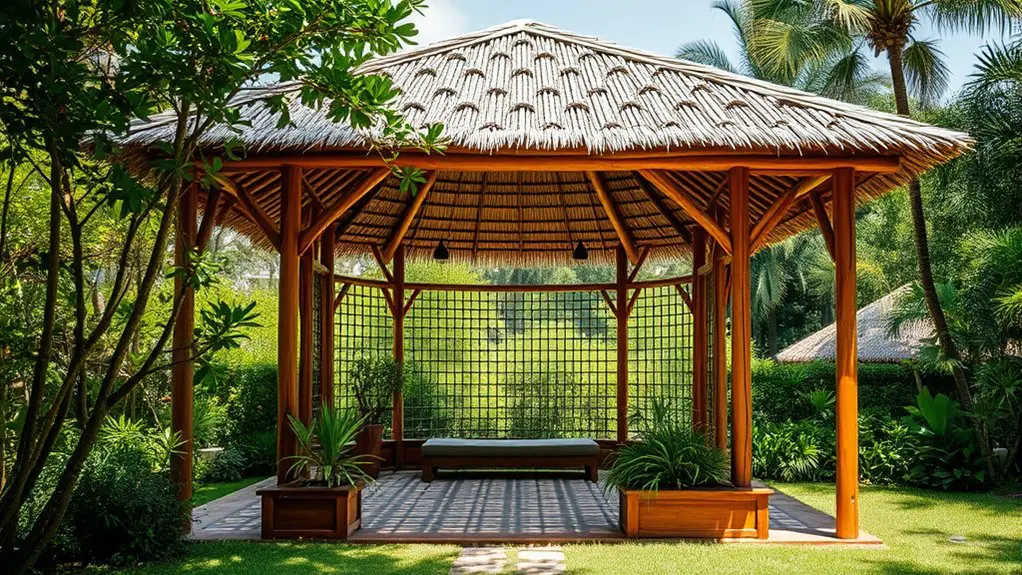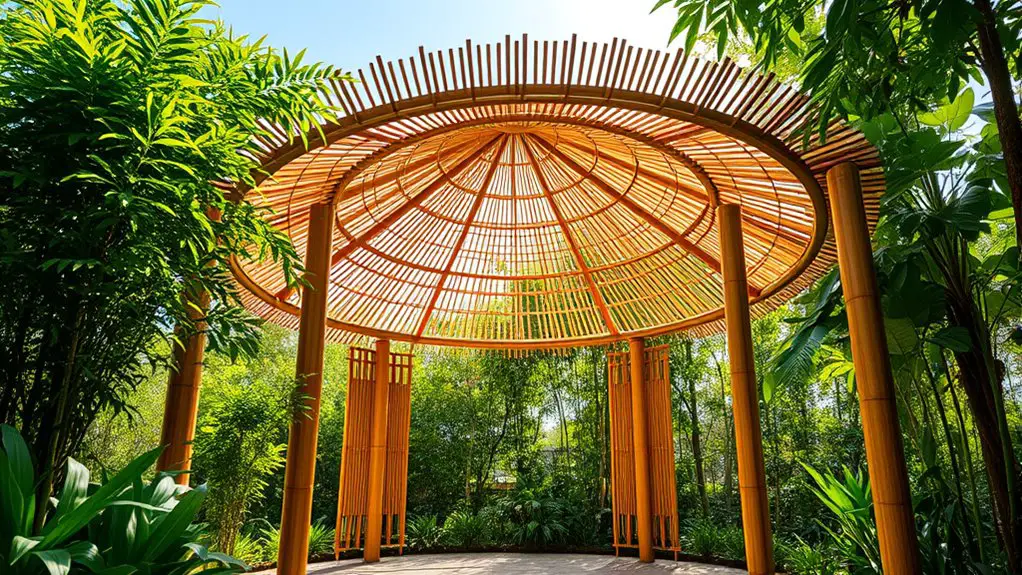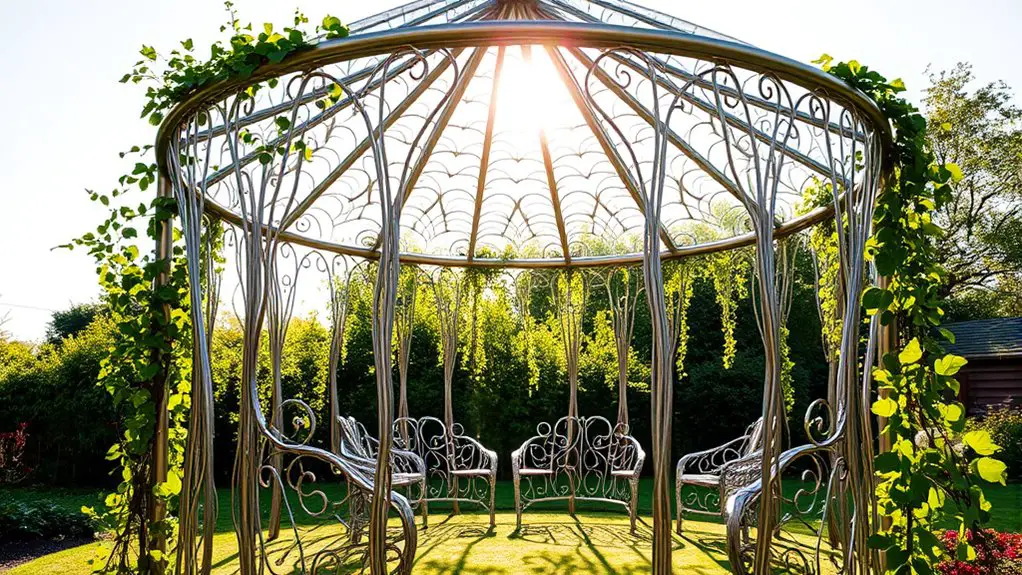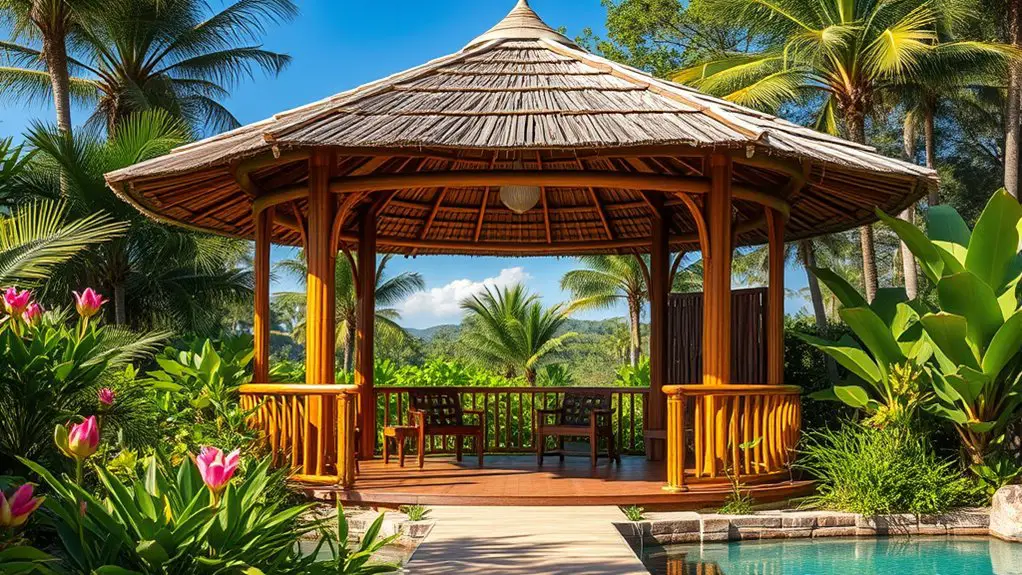Sustainable gazebo architecture emphasizes eco-friendly materials that have minimal environmental impact. Consider using reclaimed wood for its character and durability, bamboo for its rapid renewability, or recycled metals for their strength. Eco-friendly paints enhance safety and aesthetics, while innovative features like green roofs and solar power can optimize efficiency. By choosing the right materials, you not only create a functional space but also contribute to environmental health. Explore how these choices can shape your outdoor oasis.
The Importance of Sustainable Design in Gazebo Architecture

As the world increasingly prioritizes environmental responsibility, the significance of sustainable design in gazebo architecture cannot be overstated. You’re likely aware that incorporating sustainable materials is essential for minimizing ecological footprints. When you choose materials like bamboo, recycled metal, or responsibly sourced wood, you’re not just building a structure; you’re contributing to a healthier planet.
Moreover, adopting eco-friendly practices during the construction process enhances the sustainability of your gazebo. This includes using non-toxic finishes, energy-efficient lighting, and water-saving systems. Such choices not only create a safer environment but also promote a lifestyle that values harmony with nature. Additionally, selecting naturally resistant wood types can significantly reduce long-term maintenance and environmental impact.
In essence, sustainable design in gazebo architecture empowers you to enjoy outdoor spaces while respecting the Earth. By making informed decisions, you foster an environment where freedom and sustainability coexist, allowing future generations to appreciate the beauty of nature just as you do today.
Reclaimed Wood: A Timeless Choice
Reclaimed wood stands out as a timeless choice for gazebo construction, blending sustainability with aesthetic appeal. When you opt for reclaimed wood, you’re not just choosing a material; you’re embracing a rich history and unique reclaimed aesthetics that add character to your gazebo. Each piece tells a story, enhancing the visual charm of your outdoor space while promoting environmental stewardship.
The environmental impact of using reclaimed wood is markedly lower than that of new lumber, as it reduces waste and minimizes deforestation. By repurposing wood from old structures, you help divert materials from landfills and decrease the demand for new timber.
Additionally, the durability of reclaimed wood often surpasses that of newer varieties, giving you a long-lasting structure that requires less maintenance. Ultimately, choosing reclaimed wood for your gazebo allows you to craft an inviting space that’s both beautiful and responsible, aligning with your values of freedom and sustainability. Moreover, proper material selection significantly influences the quality and longevity of your gazebo.
Bamboo: A Rapidly Renewable Resource

Bamboo stands out as a rapidly renewable resource, offering impressive strength and durability for gazebo construction. Its ability to sequester carbon makes it an environmentally friendly choice that contributes to sustainability. Plus, its versatility allows for innovative design applications, ensuring that your gazebo can be both functional and aesthetically pleasing.
Strength and Durability
While many materials are praised for their strength, few can match the durability and resilience of bamboo, a rapidly renewable resource. Its exceptional structural integrity and material longevity make it an excellent choice for sustainable gazebo architecture. Here’s a quick comparison of bamboo’s properties against traditional materials:
| Material | Strength (MPa) | Durability (Years) | Sustainability Rating |
|---|---|---|---|
| Bamboo | 100-150 | 20-30 | High |
| Steel | 250-400 | 50+ | Moderate |
| Concrete | 30-50 | 75+ | Low |
| Wood | 40-60 | 10-15 | Variable |
Choosing bamboo allows you to embrace freedom in design while ensuring your structure stands the test of time. It’s a smart, eco-friendly option for those who prioritize sustainability.
Carbon Sequestration Benefits
As you explore sustainable materials for gazebo architecture, it’s crucial to contemplate the carbon sequestration benefits that bamboo offers. This rapidly renewable resource not only enhances climate resilience but also greatly reduces your carbon footprint. Here are four key benefits of using bamboo:
- Fast Growth: Bamboo can grow up to 3 feet per day, quickly absorbing carbon dioxide.
- Carbon Storage: It stores more carbon per hectare than many hardwood trees, aiding in climate change mitigation.
- Sustainable Harvesting: Harvesting bamboo doesn’t kill the plant, ensuring ongoing carbon sequestration.
- Low Emissions: The production of bamboo materials typically results in lower greenhouse gas emissions compared to traditional wood.
Versatile Design Applications
When considering sustainable design options, you’ll find that bamboo stands out due to its remarkable versatility. Its lightweight nature and rapid renewability make it ideal for creating modular designs and multifunctional spaces. You can easily adapt bamboo structures to various uses, ensuring they fit seamlessly into any environment. Here’s an overview of bamboo’s applications:
| Application | Benefits | Design Considerations |
|---|---|---|
| Gazebo Structures | Quick installation, aesthetic appeal | Customizable shapes and sizes |
| Furniture | Durable, eco-friendly | Multi-use functionality |
| Wall Panels | Insulation properties, lightweight | Easy to install and replace |
| Flooring | Natural look, sustainable source | Resilient underfoot, low maintenance |
Utilizing bamboo in your designs not only enhances aesthetics but also embraces sustainable living.
Recycled Metals: Strength and Durability

When considering recycled metals for your gazebo, you’ll find they offer impressive strength and durability, making them ideal for long-lasting structures. Their design versatility allows for creative aesthetics, enhancing your outdoor space while promoting sustainability. Plus, using recycled materials greatly reduces environmental impact, aligning with eco-friendly building practices.
Benefits of Recycled Metals
While many people might not consider the materials used in construction, recycled metals offer significant advantages regarding strength and durability. By choosing recycled metal applications, you’re not only enhancing your gazebo’s longevity but also contributing to a sustainable future. Here are four key benefits:
- High Strength-to-Weight Ratio: Recycled metals maintain structural integrity without adding excessive weight.
- Corrosion Resistance: Many recycled metals resist rust and degradation, ensuring your gazebo lasts.
- Eco-Friendly Production: Sustainable metal sourcing reduces energy consumption and greenhouse gas emissions.
- Cost-Effective: Using recycled materials often lowers costs, making your project more budget-friendly.
Design Versatility and Aesthetics
Recycled metals not only provide strength and durability but also offer remarkable design versatility and aesthetic appeal for your gazebo. By embracing modern materials, you can create structures that seamlessly integrate with various environments, enhancing your outdoor space. With recycled metals, you’ll find a range of finishes and textures that allow for creative expression—whether you prefer a sleek, contemporary look or a rustic, industrial vibe. This flexibility in design means you can achieve aesthetic integration that complements your home’s architecture and landscape. Additionally, the durability of recycled metals guarantees that your gazebo will withstand the elements, maintaining its beauty over time. Choose recycled metals to craft a gazebo that reflects your unique style while standing strong for years to come.
Environmental Impact and Sustainability
Although many materials can be used in gazebo construction, opting for recycled metals stands out due to their significant environmental benefits. Using these materials not only promotes energy efficiency but also contributes to waste reduction. Here are four compelling reasons to choose recycled metals:
- Strength and Durability: Recycled metals maintain structural integrity, ensuring your gazebo lasts longer.
- Lower Carbon Footprint: The recycling process consumes less energy than producing new metals, reducing greenhouse gas emissions.
- Resource Conservation: Utilizing recycled materials helps preserve natural resources and minimizes waste.
- Versatile Design Options: Recycled metals can be crafted into various styles, giving you freedom in your gazebo design.
Incorporating recycled metals into your gazebo project is a sustainable choice that aligns with eco-friendly principles.
Eco-Friendly Paints and Finishes
Choosing eco-friendly paints and finishes is essential for anyone looking to create a sustainable gazebo, as these options not only reduce environmental impact but also contribute to healthier living spaces. Eco-friendly pigments, derived from natural sources, offer vibrant colors without the harmful chemicals found in conventional paints. These alternatives minimize volatile organic compounds (VOCs), guaranteeing the air quality around your gazebo stays pristine.
When selecting sustainable finishes, consider options like water-based stains or natural oils, which protect wooden surfaces while being gentle on the environment. Not only do these finishes enhance the beauty of your gazebo, but they also guarantee longevity without compromising ecological integrity. By opting for eco-friendly paints and finishes, you’re not just making a choice for aesthetics; you’re embracing a lifestyle that prioritizes health, sustainability, and freedom from toxic materials. Ultimately, these choices reflect a commitment to a greener future.
Natural Stone: A Sustainable Aesthetic
Natural stone offers a unique combination of durability and beauty, making it an ideal choice for sustainable gazebo architecture. You’ll appreciate its design versatility, as it can complement various styles while maintaining an organic aesthetic. Additionally, the longevity of natural stone reduces the need for replacements, further enhancing its sustainability credentials.
Benefits of Natural Stone
While many materials can contribute to sustainable architecture, natural stone stands out for its unique combination of aesthetic appeal and environmental benefits. Its inherent qualities provide numerous advantages for your gazebo design. Here are four key benefits of using natural stone:
- Natural Stone Aesthetics: It brings a timeless beauty, enhancing your outdoor space with unique textures and colors.
- Natural Stone Durability: Resistant to weathering and wear, it guarantees long-lasting structures with minimal maintenance.
- Eco-Friendly: Sourced sustainably, it has a low carbon footprint compared to synthetic alternatives.
- Thermal Regulation: Natural stone’s thermal mass helps moderate temperatures, contributing to energy efficiency.
Design Versatility and Appeal
The appeal of natural stone in gazebo design extends beyond its durability and eco-friendliness; it also offers remarkable design versatility. You can seamlessly incorporate it into minimalist designs, allowing for clean lines and an uncluttered aesthetic. This material’s unique textures and colors enable you to create stunning focal points that enhance the overall ambiance. Additionally, natural stone is perfect for multifunctional spaces, enabling your gazebo to serve as a cozy outdoor living area or an artistic retreat. By integrating stone with other sustainable materials, you can achieve a harmonious and balanced look, providing an inviting escape that resonates with nature. Ultimately, natural stone elevates your gazebo’s design, combining beauty with practicality in a sustainable manner.
Green Roofs and Living Walls for Gazebos
Incorporating green roofs and living walls into gazebo design not only enhances aesthetic appeal but also contributes to environmental sustainability. These features can transform your outdoor space and provide numerous benefits, including:
- Improved Air Quality: Green roofs filter pollutants and produce oxygen, creating a healthier environment.
- Energy Efficiency: The insulation provided by green roofs can reduce heating and cooling costs, showcasing green roof benefits.
- Biodiversity Support: Living walls attract various species, promoting biodiversity and a vibrant ecosystem.
- Rainwater Management: Green roofs absorb rainwater, reducing runoff and minimizing erosion.
While living wall maintenance is essential, investing time in upkeep guarantees that these installations thrive and continue to provide their advantages. Your gazebo can become a sanctuary, blending nature with architecture, all while supporting a sustainable lifestyle. Embrace these eco-friendly features and enjoy the freedom they bring to your outdoor experience.
Sustainable Landscaping Around Your Gazebo
To create a harmonious and sustainable landscape around your gazebo, consider integrating native plants that thrive in your local climate and require minimal maintenance. These plants not only enhance the beauty of your outdoor space but also support local wildlife and promote water conservation.
Here’s a quick comparison of some popular native plants you might choose:
| Plant Type | Benefits |
|---|---|
| Wildflowers | Attract pollinators |
| Grasses | Erosion control |
| Shrubs | Habitat for birds |
| Ferns | Low water needs |
| Ground Covers | Weed suppression |
Innovations in Solar Power for Gazebos
As solar technology continues to advance, integrating solar power into gazebo design not only enhances functionality but also promotes sustainability. By utilizing solar panel integration, you can enjoy an eco-friendly space that encourages independence from traditional power sources. Here are four innovations to ponder:
- Solar Roof Tiles: These blend seamlessly with your gazebo’s design while generating electricity.
- Portable Solar Generators: Perfect for off-grid solutions, they provide power for lighting and small appliances.
- Solar-Powered LED Lighting: These fixtures enhance ambiance while reducing energy costs and environmental impact.
- Smart Solar Systems: These allow you to monitor energy usage and optimize power efficiency from your gazebo. Additionally, incorporating energy efficiency features can significantly lower long-term operational costs.
The Future of Sustainable Gazebo Design
While the demand for sustainable outdoor spaces grows, the future of gazebo design is poised to embrace innovative materials and technologies that prioritize environmental stewardship. You’ll likely see a rise in smart technology integration, allowing for energy-efficient lighting and climate control systems that adapt to your needs. Imagine a gazebo that adjusts its features based on weather conditions, enhancing both comfort and sustainability.
Modular designs will also become a hallmark of future gazebos, offering flexibility and customization. These structures can be easily expanded or reconfigured to suit your changing lifestyle or space requirements. By using eco-friendly materials, such as reclaimed wood or recycled composites, these designs not only minimize environmental impact but also promote a sense of connection to nature. Additionally, many modern gazebos feature high-quality cedar wood, known for its natural resistance to rot and weather elements, which enhances durability and sustainability.
Ultimately, the future of gazebo design will reflect a harmonious blend of innovation, functionality, and eco-consciousness, giving you the freedom to enjoy outdoor living sustainably.
Frequently Asked Questions
What Are the Costs Associated With Building a Sustainable Gazebo?
Building a sustainable gazebo? Well, you’ll need a budget that sings and material choices that dance. Costs can fluctuate wildly, so don’t forget to account for eco-friendly options that might just break the bank!
How Can I Maintain My Eco-Friendly Gazebo Materials?
To maintain your eco-friendly gazebo materials, follow these maintenance tips: regularly clean surfaces, apply natural sealants, inspect for damage, and avoid harsh chemicals. This eco-friendly care guarantees longevity and preserves the beauty of your structure.
Are There Local Regulations for Sustainable Gazebo Construction?
As you envision your serene gazebo amidst rustling leaves, check local zoning laws and construction permits. These regulations guarantee your dream structure stands tall and safe, blending harmoniously into nature while respecting community guidelines.
Can I Incorporate Sustainable Design in a Pre-Existing Gazebo?
You can definitely incorporate sustainable design in your pre-existing gazebo. Consider green upgrades like energy-efficient lighting and design modifications such as rainwater collection systems to enhance its eco-friendliness while maintaining your creative freedom.
What Styles of Sustainable Gazebos Are Currently Trending?
Did you know that 70% of homeowners prefer modern designs with natural aesthetics? Today’s trending sustainable gazebos blend sleek lines and organic materials, creating spaces that reflect both contemporary style and a deep connection to nature.

